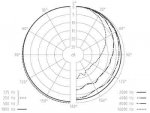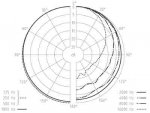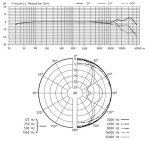I am searching for info on the potential pitfalls and advantages of using multiple omni mics (up to 3) on sources such as a drum kit, etc.
Are omnis subject to the same considerations regarding Phase issues (3 to 1 rule etc.) as other types of mics?
Are we talking as overheads or as close mics? With stereo overheads the 3:1 rule doesn't apply as you aren't mixing the sources, you are recording left and right, and the phase differences are your stereo image with omnis. If you try to set a stereo pair that "obeys" the 3:1 rule you'll get a stupid wide stereo image (read: giant hole in middle). You'd need the overheads 10 feet apart or something silly.
For close mics and avoiding bleed, yes in theory you need to get a bit closer, but practically you probably already have your close mics at a higher ratio.
Can omnis be used in XY configuration?
Sure, but your stereo image will be limited to >10kHz or so, depending on diaphragm size. You would only do that if you wanted a very narrow stereo image. Omnis are traditionally spaced.
What are the differences between nearfield and diffusefield omnis?
Technically it's "free-field" and diffuse-field. Diffuse-field has signal arrivals from random (all) directions, free-field is a theoretical reflection-free environment (outside or an anechoic chamber). As the room gets large and you get relatively closer to source vs. size of room, then you approximate a free field. That is why you might think of it as "near-field"; because you'd probably want to select a free-field omni for close-micing.
The difference is diffuse-field omnis are designed to be flat off-axis, but they will have a rising high frequency response on-axis (again dependent upon diaphragm size, but let's use the same >10kHz figure). Free-field omnis are flat on-axis, but will have a decreasing high frequency response off-axis (in theory you don't care because there are no off-axis signals).
The amount of difference between on- and off-axis high frequency response is mainly dependent on diaphragm size; in theory a point-sized capsule will exhibit no difference. As capsule size grows, the difference gets larger. Some omnis are designed with accessories that can accent the on-axis response (and decrease the off-axis response), like the DPA APE (acoustic pressure equalizer) balls. This effect is frequency-dependent according to the size of the device; at the large extreme you get a boundary mic.
Normally you would select diffuse-field for applications like recording an ensemble and free-field for close micing, but truthfully if you have a HF shelving EQ (like on practically every mixer) you can convert from one to the other.
Do omni condensers and dynamics behave in the same manner?
As far as everything above, yes, but consider that due to operating principle omni dynamics have far less high frequency response than condensers, so it makes all points related to high frequency response moot. Pretty much all dynamics are designed for nearfield use because they don't have a choice; signal-to-noise will be unacceptable on most far-field sources.
And please feel free to add any other words of wisdom regarding the use of omni mics.
Use them, early and often.

 For you'll get a lot of the room in your recording.
For you'll get a lot of the room in your recording.




